know 7 Proven Quiet Pet Birds for for Happy Apartments

Table of Contents
Are you considering adding a feathered friend to your family but worried about noise complaints from neighbors? You’re not alone! As apartment living becomes increasingly common, finding quiet pet birds that won’t disturb the peace has become a top priority for many prospective bird owners.
The good news is that not all birds are created equal when it comes to noise levels. While some species are known for their ear-piercing squawks and constant chatter, others communicate with gentle chirps and melodious songs that are much more neighbor-friendly.
In this comprehensive guide, we’ll explore the world of quiet pet birds, discussing everything from the quietest species to practical strategies for minimizing bird noise in your home. Whether you’re a first-time bird owner or looking to add a more peaceful companion to your existing flock, this article will help you make an informed decision.
Understanding Bird Noise: What to Expect
Before diving into specific species, it’s important to set realistic expectations: no bird is completely silent. Birds are naturally vocal creatures that use sounds to communicate, express emotions, and interact with their environment.
Bird vocalizations fall into several categories:
- Songs and calls: Used for communication, territorial marking, and attracting mates
- Chattering and talking: Some species can mimic human speech or environmental sounds
- Contact calls: Short vocalizations birds use to stay in touch with their flock
- Alarm calls: Loud, sharp sounds made when birds feel threatened
Beyond vocalizations, birds also create other noises through their activities:
- Cage bar rattling
- Wing flapping
- Toys being moved or played with
- Seed husking and eating sounds
When seeking quiet pet birds, understand that “quiet” is relative. Even the most peaceful species will make some noise—the difference lies in the volume, frequency, and duration of these sounds. The goal is finding a bird whose natural vocalizations align with your living situation and noise tolerance.
Top 7 Quiet Pet Birds for Apartments
1. Canaries
| Size | Lifespan | Care Level | Noise Level (1-5) |
|---|---|---|---|
| Small (4-5 inches) | 10-15 years | Beginner | 2 |
Description: Canaries are among the most popular pet birds, known for their beautiful colors and melodious singing. Males are the primary singers, producing sweet, pleasant melodies that are rarely disruptive.
Noise Level Analysis: Unlike many birds that screech or squawk, canaries produce soft, musical songs that blend into background noise. Their vocalizations are typically limited to daylight hours and rarely reach volumes that would disturb neighbors. Compared to parrots or cockatiels, canaries are significantly quieter.
Pros:
- Beautiful, gentle songs rather than harsh calls
- Independent nature requires less interaction
- Stunning variety of colors and patterns
- Don’t need a companion bird
Cons:
- Less interactive than some other pet birds
- Males sing more than females (a pro or con, depending on preference)
- Not typically handleable like larger birds
Care Requirements: Canaries thrive in spacious cages that allow for flight, with a diet primarily consisting of high-quality canary seed mix supplemented with fresh vegetables and fruits. They appreciate simple toys and perches of varying diameters.
Is This Bird Right for You? Canaries are ideal for those who want to enjoy bird watching and gentle singing without significant hands-on interaction. They’re perfect for apartment dwellers who appreciate natural ambiance without disruptive noise.
2. Finches (Zebra Finches, Society Finches)
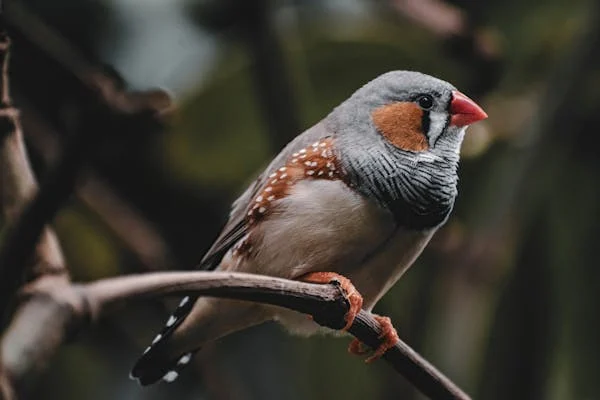
| Size | Lifespan | Care Level | Noise Level (1-5) |
|---|---|---|---|
| Tiny (3-4 inches) | 5-9 years | Beginner | 1-2 |
Description: Finches are tiny, active birds that make delightful pets for those with limited space. Zebra finches and society finches are particularly popular due to their gentle temperaments and minimal noise.
Noise Level Analysis: Finches produce soft, pleasant chirps and tweets that are barely audible from another room. Their vocalizations are typically conversational in nature—quiet chatter among themselves rather than attention-seeking calls. The sound is often described as a gentle “beep” or “tweet” that creates a soothing background ambiance.
Pros:
- Extremely low-volume vocalizations
- Entertaining to watch with constant movement
- Require minimal handling
- Thrive with same-species companions
Cons:
- Not interested in human interaction
- Should be kept in pairs or small groups
- Too fragile for handling
Care Requirements: Finches need horizontal cages that provide ample flying space, multiple perches, and hiding spots. Their diet consists of a quality finch seed mix, supplemented with fresh greens and egg food for protein.
Is This Bird Right for You? Finches are perfect for those who want to enjoy watching bird behavior without significant interaction. Their quiet nature makes them ideal for apartments with thin walls, and they’re compatible with busy lifestyles that might not accommodate more demanding pets.
3. Bourke’s Parakeets
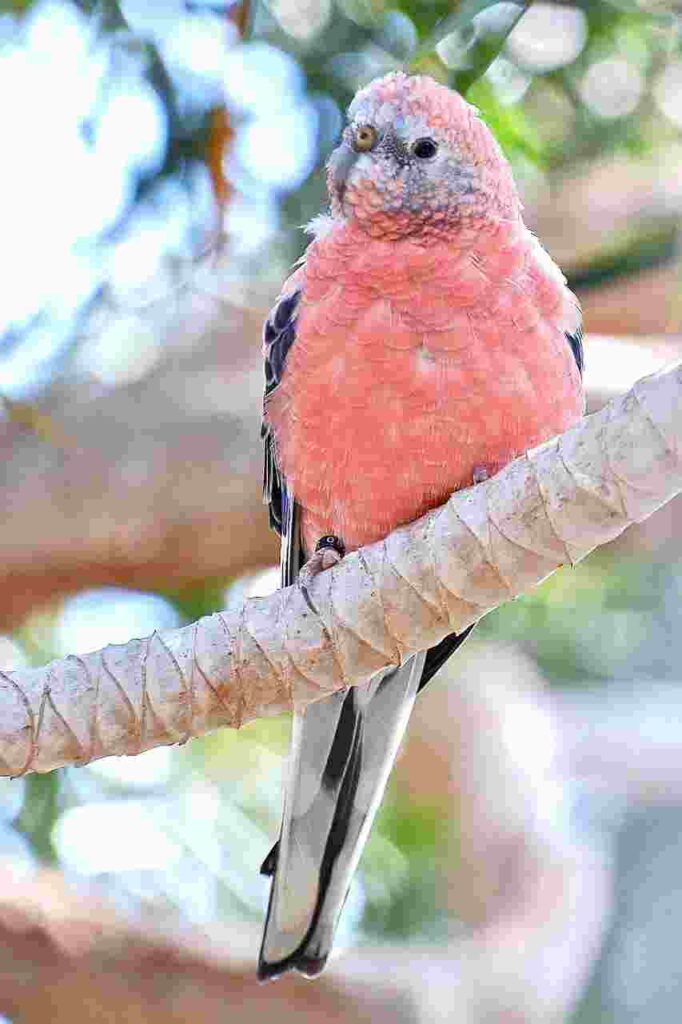
| Size | Lifespan | Care Level | Noise Level (1-5) |
|---|---|---|---|
| Small (7-8 inches) | 8-15 years | Beginner-Intermediate | 2 |
Description: Often overlooked in favor of their more common budgie cousins, Bourke’s parakeets are peaceful, gentle birds with a calm disposition. They showcase beautiful pink and brown plumage with blue accents.
Noise Level Analysis: Bourke’s parakeets are known as the “quiet parakeets,” producing soft warbling and chirping sounds primarily at dawn and dusk. Their vocalizations are melodious and significantly quieter than most other parakeet species. Even their contact calls are subdued compared to budgies or cockatiels.
Pros:
- Exceptionally quiet for a parakeet species
- Gentle, non-aggressive temperament
- Crepuscular (most active at dawn/dusk)
- Can be kept in pairs or small groups
Cons:
- Not as readily available as other species
- Less interactive than some larger parrots
- May be shy initially
Care Requirements: Bourke’s parakeets need a medium-sized cage with plenty of perches and simple toys. They thrive on a diet of quality parakeet seed mix, pellets, and fresh vegetables. They appreciate regular but gentle interaction.
Is This Bird Right for You? Bourke’s parakeets are ideal for those seeking a quiet, low-maintenance bird with a gentle disposition. They’re perfect for apartments and evening-focused lifestyles, as they’re most active when you’re likely home from work.
4. Diamond Doves

| Size | Lifespan | Care Level | Noise Level (1-5) |
|---|---|---|---|
| Small (7-8 inches) | 10-15 years | Beginner | 1-2 |
Description: Diamond doves are diminutive members of the dove family, native to Australia. They feature delicate gray plumage with distinctive white speckles on their wings, giving them their “diamond” name.
Noise Level Analysis: These doves produce extremely soft, gentle cooing sounds that are barely audible beyond the same room. Unlike larger doves, their vocalizations are subtle and soothing. The gentle “coo-coo” is reminiscent of the sound of larger doves, but at a volume that’s perfect for apartment living.
Pros:
- Among the quietest birds available as pets
- Peaceful, gentle temperament
- Beautiful, delicate appearance
- Calming presence in the home
Cons:
- Prefer aviary settings to cages
- Should be kept in pairs
- Not typically handleable
Care Requirements: Diamond doves benefit from the largest cage possible or, ideally, a small aviary. They require a diet of small seeds (finch or canary mix), supplemented with greens and egg food. Ground-dwelling by nature, they appreciate low perches and floor space.
Is This Bird Right for You? Diamond doves are perfect for those who prioritize tranquility and beauty over interaction. Their exceptionally quiet nature makes them suitable for even the strictest apartment settings, and they create a peaceful ambiance with their gentle movements and soft coos.
5. Parrotlets
| Size | Lifespan | Care Level | Noise Level (1-5) |
|---|---|---|---|
| Tiny (4-5 inches) | 15-20 years | Intermediate | 2-3 |
Description: Often called “pocket parrots,” parrotlets are the smallest true parrots kept as pets. Despite their diminutive size, they pack big personalities into tiny packages, with intelligence and curiosity rivaling their larger cousins.
Noise Level Analysis: Parrotlets produce high-pitched chirps and chatter, but their small size limits volume. They lack the piercing screams typical of larger parrots, making them considerably apartment-friendly. When they do vocalize, it’s usually brief and not loud enough to penetrate walls or disturb neighbors.
Pros:
- True parrot personality without the noise level
- Can learn to talk (though with tiny voices)
- Highly intelligent and trainable
- Form strong bonds with owners
Cons:
- Can be territorial and nippy if not properly socialized
- Require daily interaction and mental stimulation
- May become louder when seeking attention
Care Requirements: Parrotlets need spacious cages with plenty of toys that challenge their intelligence. Their diet should consist of high-quality pellets, a variety of seeds, and fresh fruits and vegetables. Daily out-of-cage time and interaction are essential.
Is This Bird Right for You? Parrotlets are ideal for those seeking an interactive, parrot-like companion without the volume of larger species. They’re suitable for apartments but require dedicated time and attention to thrive. They’re best for households where someone is regularly home to provide stimulation.
6. Budgerigars (Budgies/Parakeets)
| Size | Lifespan | Care Level | Noise Level (1-5) |
|---|---|---|---|
| Small (7-8 inches) | 5-10 years | Beginner | 3 |
Description: Budgies are the most popular pet birds worldwide, known for their playful attitudes, charming personalities, and ability to mimic speech. These colorful small parrots come in a variety of color mutations.
Noise Level Analysis: While not the quietest birds on this list, properly socialized budgies produce moderate chirping and chatter that’s generally not disruptive. Their vocalizations tend to be conversational rather than screaming, though they can become louder when excited or seeking attention. Compared to larger parrots like cockatoos or macaws, their noise level is significantly lower.
Pros:
- Highly interactive and playful
- Can learn to talk and perform tricks
- Affordable and readily available
- Adaptable to various living situations
Cons:
- More vocal than some birds on this list
- Can develop louder habits if not properly socialized
- Morning chirping can be enthusiastic
Care Requirements: Budgies need a spacious cage with toys that encourage activity and mental stimulation. Their diet should include a quality budgie seed mix or pellets, supplemented with fresh vegetables. Regular handling and social interaction are important for taming.
Is This Bird Right for You? Budgies are suitable for those seeking an interactive companion with moderate noise levels. With proper training and environmental management, they can adapt well to apartment living. They’re ideal for first-time bird owners who want engagement without the volume of larger parrots.
7. Pionus Parrots
| Size | Lifespan | Care Level | Noise Level (1-5) |
|---|---|---|---|
| Medium (10-12 inches) | 25-30 years | Intermediate | 2-3 |
Description: Pionus parrots are medium-sized birds known for their calm demeanor and relatively quiet nature. Several species fall under the Pionus category, with the Blue-headed, Bronze-winged, and Maximilian’s being among the most popular.
Noise Level Analysis: Among medium to large parrots, Pionus are renowned for their quieter dispositions. They lack the ear-piercing screams typical of many parrots, instead producing lower-pitched squawks and chatters that are less likely to disturb neighbors. Their vocalizations are typically brief and purposeful rather than constant.
Pros:
- The quietest of the medium-sized true parrots
- Calm, gentle disposition
- Less demanding than many other parrot species
- Long lifespan for a dedicated companion
Cons:
- Still louder than smaller birds on this list
- Significant long-term commitment
- Higher initial cost than smaller birds
Care Requirements: Pionus parrots need spacious cages with sturdy toys and perches. They require a high-quality pelleted diet supplemented with fresh fruits and vegetables. Regular out-of-cage time and interaction are important for their mental health.
Is This Bird Right for You? Pionus parrots are ideal for those seeking a larger companion bird without extreme noise levels. They’re suitable for apartments with reasonable soundproofing and understanding neighbors. These birds are best for committed owners who appreciate their subtle, gentle personalities and can provide lifelong care.
Factors Influencing Bird Noise (Beyond Species)
While species selection is a crucial factor in finding a quiet pet bird, several other elements influence how vocal your feathered friend will be:
Environment
- Cage size: Inadequate space can lead to stress and increased vocalization
- Location: Placing cages near windows or busy areas can stimulate excess calling
- Stimulation: Appropriate toys and environmental enrichment reduce boredom-related noise
- Multiple birds: Some birds are quieter in pairs (finches, canaries), while others may encourage each other’s vocalizations
Socialization
- Human interaction: Birds that receive regular, positive attention are typically less demanding and noisy
- Training: Consistent training can help birds understand when quieter behavior is appropriate
- Routine: Established daily patterns provide security and reduce anxiety-related calls
Diet
- Nutritional balance: Proper nutrition contributes to overall well-being and behavior
- Feeding schedule: Regular meal times create predictability and reduce food-seeking calls
- Foraging opportunities: Puzzle toys and foraging activities provide mental stimulation that reduces boredom-related noise
Health
- Regular check-ups: Addressing health issues promptly prevents pain-related vocalizations
- Hormonal cycles: Understanding natural hormonal changes helps manage seasonal increases in vocalization
- Age-related factors: Young birds are typically more vocal during development phases
Proven Strategies for Minimizing Bird Noise
Even with naturally quieter species, implementing these strategies can further reduce potential noise issues:
Smart Cage Placement
Position your bird’s cage away from windows, which can trigger territorial calls, and avoid high-traffic areas that might cause startling or anxiety. Creating a secure corner with partial coverage can help your bird feel safe and reduce the need for contact calls.
Effective Cage Covers
Using a breathable, dark cage cover at night not only mimics natural sleeping conditions but also dampens early morning vocalizations. Gradually removing the cover as part of a morning routine creates predictability that many birds respond well to.
Enrichment & Mental Stimulation
Provide a variety of appropriate toys that encourage natural behaviors:
- Foraging toys: Hide treats in puzzle toys to stimulate mental activity
- Chewable items: Offer safe woods and fibers for natural chewing behaviors
- Rotating selection: Change toys regularly to maintain interest
Training & Socialization Techniques
Spend quality time with your bird daily:
- Positive reinforcement: Reward quiet behavior rather than responding to loud calls
- Consistent interaction: Regular, scheduled playtime reduces attention-seeking noise
- Handling practice: Gentle handling builds trust and security
Simple Soundproofing Solutions
Consider these apartment-friendly options:
- Acoustic panels: Decorative wall panels can absorb sound waves
- Heavy curtains: Reduce both external triggers and sound transmission
- Rugs and soft furnishings: Minimize echo and sound reflection
- White noise machines: Create ambient background sound that masks bird vocalizations
Consistent Daily Routine
Birds thrive on predictability:
- Regular sleep schedule: 10-12 hours of undisturbed darkness promotes healthier behavior
- Consistent feeding times: Reduces food-seeking calls
- Predictable interaction: Scheduled playtime satisfies social needs
Optimal Nutrition
A well-fed bird is typically a quieter bird:
- Species-appropriate diet: Research specific nutritional needs for your bird
- Fresh foods: Provide variety with appropriate fruits, vegetables, and proteins
- Foraging opportunities: Scatter food or use foraging toys to extend feeding time
Debunking Myths About Quiet Birds
Let’s address some common misconceptions:
Myth: “Keeping a bird’s wings clipped will make it quieter.” Reality: Wing clipping affects mobility but not vocalization. In fact, birds that feel vulnerable due to inability to fly may call more frequently out of insecurity.
Myth: “Female birds are always quieter than males.” Reality: While this is true for some species like canaries, it’s not universal. Female budgies and parrots can be equally vocal, and individual personality often outweighs gender differences.
Myth: “All parrots are too loud for apartments.” Reality: As we’ve seen, species like parrotlets and Pionus are relatively apartment-friendly. Individual variation, training, and environment play significant roles in noise levels.
Myth: “Birds will be quieter if kept alone.” Reality: Social species like finches and canaries actually make fewer demands for attention when kept with appropriate companions. Isolation can increase stress-related calling in these birds.
Myth: “Covering the cage whenever the bird makes noise will teach it to be quiet.” Reality: This approach can create fear and insecurity, potentially worsening behavioral issues. Positive reinforcement of quiet behavior is more effective.
Choosing a Reputable Breeder or Rescue Organization
Finding a well-socialized, healthy bird starts with selecting the right source:
Evaluating Breeders
Look for breeders who:
- Maintain clean, appropriate housing for their birds
- Willingly show you their breeding facilities
- Handle their birds regularly
- Provide health guarantees and support after purchase
- Can discuss the specific temperament of individual birds
Benefits of Adoption
Consider these advantages of rescue organizations:
- Adult birds with established personalities
- Known noise levels and behaviors
- Lower initial costs
- Opportunity to provide a home to a bird in need
- Support networks through rescue communities
Questions to Ask Before Bringing Your Bird Home
Whether from a breeder or rescue:
- What is this individual bird’s typical noise level?
- How has the bird been socialized?
- What diet is the bird currently eating?
- Has the bird received veterinary care and health checks?
- What behaviors or quirks should I be aware of?
Conclusion
Finding a quiet pet bird for your apartment involves thoughtful species selection, proper care practices, and environmental management. By choosing naturally quieter species like canaries, finches, or Bourke’s parakeets, and implementing the noise reduction strategies we’ve discussed, you can enjoy the companionship of a feathered friend without disturbing your neighbors.
Remember that every bird has a unique personality, and individual variation exists within species. Take time to meet specific birds before bringing them home whenever possible, and be prepared to adapt your approach based on your bird’s particular needs and behaviors.
Have you shared your apartment with a quiet bird companion? What strategies worked best for maintaining peace with your neighbors? Share your experiences in the comments below!
For more information on bird care, training techniques, and species-specific advice, subscribe to our newsletter or browse our recommended products for quiet pet birds.
Disclaimer: This article is intended as a general guide. Always research specific species thoroughly and consult with avian veterinarians or experienced bird keepers before bringing a new bird into your home.



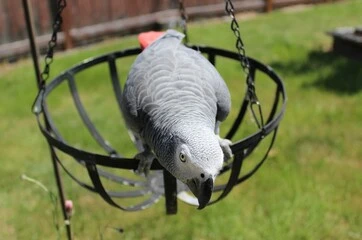
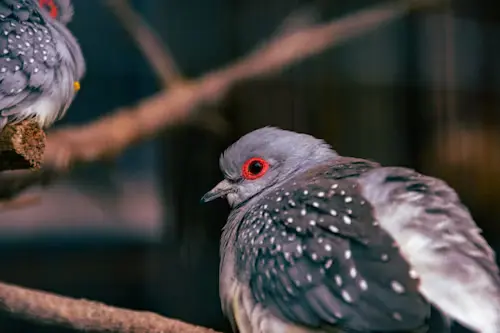
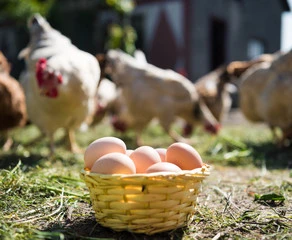
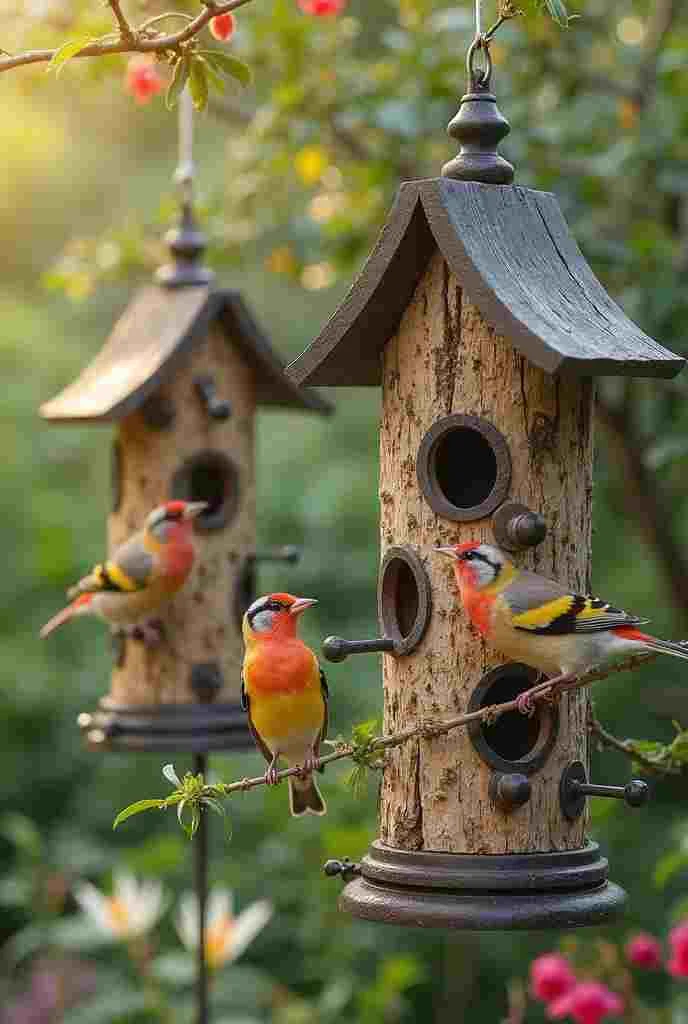
3 Comments